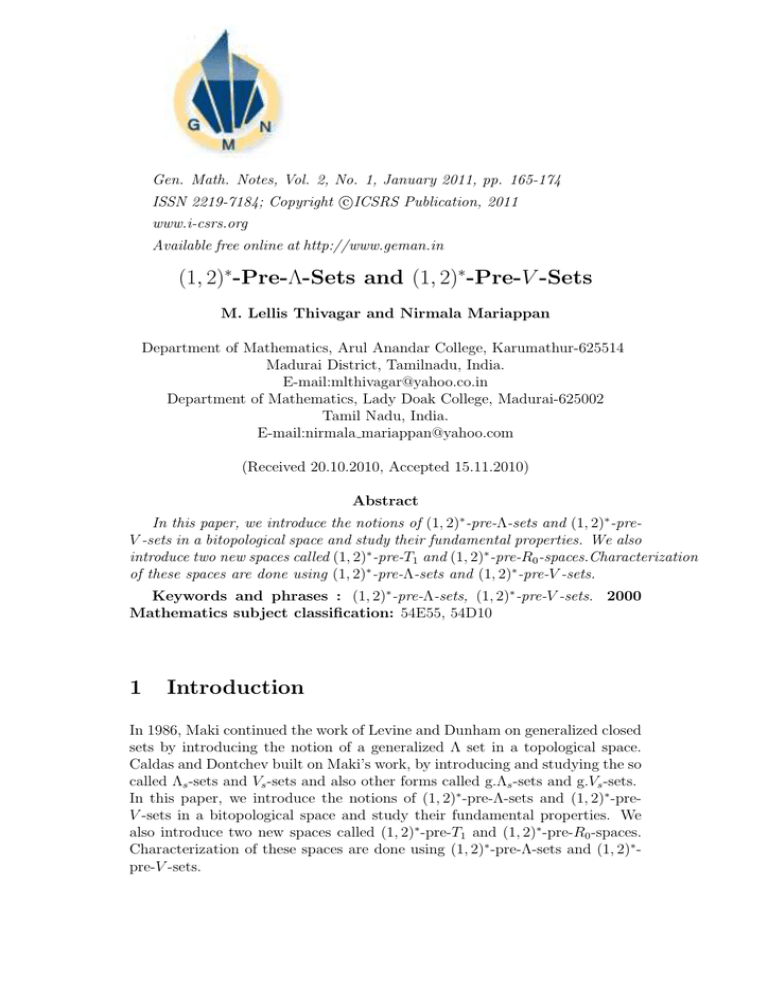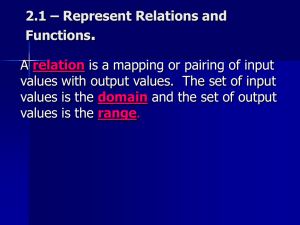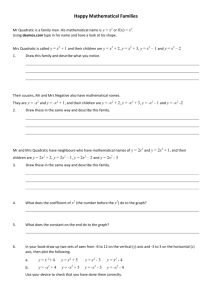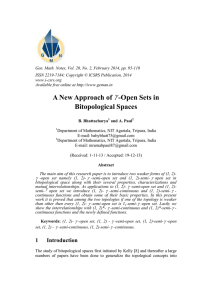Gen. Math. Notes, Vol. 2, No. 1, January 2011, pp.... ISSN 2219-7184; Copyright °ICSRS Publication, 2011
advertisement

Gen. Math. Notes, Vol. 2, No. 1, January 2011, pp. 165-174
c
ISSN 2219-7184; Copyright °ICSRS
Publication, 2011
www.i-csrs.org
Available free online at http://www.geman.in
(1, 2)∗-Pre-Λ-Sets and (1, 2)∗-Pre-V -Sets
M. Lellis Thivagar and Nirmala Mariappan
Department of Mathematics, Arul Anandar College, Karumathur-625514
Madurai District, Tamilnadu, India.
E-mail:mlthivagar@yahoo.co.in
Department of Mathematics, Lady Doak College, Madurai-625002
Tamil Nadu, India.
E-mail:nirmala mariappan@yahoo.com
(Received 20.10.2010, Accepted 15.11.2010)
Abstract
In this paper, we introduce the notions of (1, 2)∗ -pre-Λ-sets and (1, 2)∗ -preV -sets in a bitopological space and study their fundamental properties. We also
introduce two new spaces called (1, 2)∗ -pre-T1 and (1, 2)∗ -pre-R0 -spaces.Characterization
of these spaces are done using (1, 2)∗ -pre-Λ-sets and (1, 2)∗ -pre-V -sets.
Keywords and phrases : (1, 2)∗ -pre-Λ-sets, (1, 2)∗ -pre-V -sets. 2000
Mathematics subject classification: 54E55, 54D10
1
Introduction
In 1986, Maki continued the work of Levine and Dunham on generalized closed
sets by introducing the notion of a generalized Λ set in a topological space.
Caldas and Dontchev built on Maki’s work, by introducing and studying the so
called Λs -sets and Vs -sets and also other forms called g.Λs -sets and g.Vs -sets.
In this paper, we introduce the notions of (1, 2)∗ -pre-Λ-sets and (1, 2)∗ -preV -sets in a bitopological space and study their fundamental properties. We
also introduce two new spaces called (1, 2)∗ -pre-T1 and (1, 2)∗ -pre-R0 -spaces.
Characterization of these spaces are done using (1, 2)∗ -pre-Λ-sets and (1, 2)∗ pre-V -sets.
166
2
M. Lellis Thivagar and Nirmala Mariappan
Preliminaries
Throughout this paper (X, τ1 , τ2 ) and (Y, σ1 , σ2 ) ( briefly X and Y ) represent bitopological spaces on which no separation axioms are assumed unless
otherwise mentioned.
Definition 2.1 [11] A subset S of a bitopological space (X, τ1 , τ2 ) is said to be
τ1,2 -open if S = A ∪ B where A ∈ τ1 , and B ∈ τ2 . A subset S of X is said to
be τ1,2 -closed if the complement of S is τ1,2 -open.
Definition 2.2 [11] Let S be a subset of X. Then
(i) The τ1,2 -interior of S, denoted by τ1,2 -int(S), is defined by ∪{G/G ⊆ S
and G is τ1,2 -open }.
(ii) The τ1,2 -closure of S, denoted by τ1,2 -cl(S), is defined by ∩{F/S ⊆ F and
F is τ1,2 -closed }.
Remark 2.3 τ1,2 -open sets need not form a topology.
We recall the following definitions which are useful in the sequel.
Definition 2.4 [11] A subset A of a bitopological space (X, τ1 , τ2 ) is called
(i) (1, 2)∗ -semi-open if A ⊆ τ1,2 -cl(τ1,2 -int(A))
(ii) (1, 2)∗ -preopen if A ⊆ τ1,2 -int(τ1,2 -cl(A))
(iii)(1, 2)∗ -α-open if A ⊆ τ1,2 -int(τ1,2 -cl(τ1,2 -int(A)))
The complements of the sets mentioned above from (i) to (iii) are called their
respective closed sets.
3
(1, 2)∗-pre-Λ-Sets and (1, 2)∗-pre-V -Sets
First let us introduce the concepts (1, 2)∗ -Λp and (1, 2)∗ -Vp .
Definition 3.1 Let S be a subset of a bitopological space (X, τ1 , τ2 ). We define the subsets (1, 2)∗ -Λp (S) and (1, 2)∗ -Vp (S) as follows: (1, 2)∗ -Λp (S) =
∩{G : G ⊇ S and G is (1, 2)∗ -preopen} and (1, 2)∗ -Vp (S) = ∪{F : F ⊆
S and F c is (1, 2)∗ -preopen}.
First we summarise the fundamental properties of the sets (1, 2)∗ -Λp (S)
and (1, 2)∗ -Vp (S).
(1, 2)∗ -Pre-Λ-sets and (1, 2)∗ -pre-V -sets
167
Lemma 3.2 For subsets A,B and Ai , i ∈ I of a bitopological space (X, τ1 , τ2 )
the following properties hold:
(1) A ⊆ (1, 2)∗ -Λp (A).
(2) A ⊆ B implies that (1, 2)∗ -Λp (A) ⊆ (1, 2)∗ -Λp (B).
(3) (1, 2)∗ -Λp ((1, 2)∗ -Λp (A)) = (1, 2)∗ -Λp (A).
(4) If A is (1, 2)∗ -preopen then A = (1, 2)∗ -Λp (A).
(5) (1, 2)∗ -Λp (∪{Ai : i ∈ I}) = ∪{(1, 2)∗ -Λp (Ai ) : i ∈ I}.
(6) (1, 2)∗ -Λp (∩{Ai : i ∈ I}) ⊆ ∩{(1, 2)∗ -Λp (Ai ) : i ∈ I}.
(7) (1, 2)∗ -Λp (X − A) = X - (1, 2)∗ -Λp (A).
Proof (1),(2),(4),(6) and (7) are immediate consequences of Definition 3.1. To
prove (3): It follows from (1) and (2) that (1, 2)∗ -Λp (A) ⊆ (1, 2)∗ -Λp ((1, 2)∗ Λp (A)). If x ∈
/ (1, 2)∗ -Λp (A), then there exists a (1, 2)∗ -preopen set G such
that A ⊆ G and x ∈
/ G. Hence (1, 2)∗ -Λp (A) ⊆ G and so x ∈
/ (1, 2)∗ -Λp ((1, 2)∗ Λp (A)). Thus (1, 2)∗ -Λp ((1, 2)∗ -Λp (A)) ⊆ (1, 2)∗ -Λp (A). To prove (5): Let A =
∪{Ai : i ∈ I}. By (2) we have that ∪{(1, 2)∗ -Λp (Ai ) : i ∈ I} ⊆ (1, 2)∗ -Λp (A).
If x ∈
/ ∪{(1, 2)∗ -Λp (Ai ) : i ∈ I}, then for each i ∈ I, there exists a (1, 2)∗ preopen set Gi such that Ai ⊆ Gi and x ∈
/ Gi . If G = ∪{Gi : i ∈ I} then G
∗
is (1, 2) -preopen with A ⊆ G and x ∈
/ G. Hence x ∈
/ (1, 2)∗ -Λp (A) and so (5)
holds.
Lemma 3.3 For subsets A,B and Ai , i ∈ I of a bitopological space (X, τ1 , τ2 )
the following properties hold:
(1) (1, 2)∗ -Vp (A) ⊆ A..
(2) A ⊆ B implies that (1, 2)∗ -Vp (A) ⊆ (1, 2)∗ -Vp (B).
(3) (1, 2)∗ -Vp ((1, 2)∗ -Vp (A)) = (1, 2)∗ -Vp (A).
(4) If A is (1, 2)∗ -preclosed then A = (1, 2)∗ -Vp (A).
(5) (1, 2)∗ -Vp (∩{Ai : i ∈ I}) = ∩{(1, 2)∗ -Vp (Ai ) : i ∈ I}.
(6) ∪{(1, 2)∗ -Vp (Ai ) : i ∈ I} ⊆ (1, 2)∗ -Vp (∪{Ai : i ∈ I}).
Proof (1),(2),(4) and (6) follow from Definitions 3.1. To prove (3): By (1)
and (2) we have (1, 2)∗ -Vp ((1, 2)∗ -Vp (A)) ⊆ (1, 2)∗ -Vp (A). If x ∈ (1, 2)∗ -Vp (A)
then for some (1, 2)∗ -preclosed set F ⊆ A, x ∈ F . Then F ⊆ 1, 2)∗ -Vp (A)
by Definition 3.1. Since F is (1, 2)∗ -preclosed, again by Definition 3.1, x ∈
F ⊆ (1, 2)∗ -Vp ((1, 2)∗ -Vp (A)). To prove (5): Let A = ∩{Ai : i ∈ I}. By (2)
168
M. Lellis Thivagar and Nirmala Mariappan
we have that (1, 2)∗ -Vp (A) ⊆ ∩{(1, 2)∗ -Vp (Ai ) : i ∈ I}. If x ∈ ∩{(1, 2)∗ Vp (Ai ) : i ∈ I}, then for each i ∈ I, there exists a (1, 2)∗ -preclosed set Fi
such that Fi ⊆ Ai and x ∈ Fi . If F = ∩{Fi : i ∈ I} then F is (1, 2)∗ -preclosed
with F ⊆ A and x ∈ F . Hence x ∈ (1, 2)∗ -Vp (A) and so (5) holds.
Note that in general (1, 2)∗ -Λp (A ∩ B) 6= (1, 2)∗ -Λp (A) ∩ (1, 2)∗ -Λp (B) as the
following example shows.
Example 3.4 Let X = {a, b, c}
τ1 = {φ, {a, b}, X}; τ2 = {φ, {a, c}, X} ;
τ1,2 -open sets = {φ, {a, b}, {a, c}, X}; τ1,2 -closed sets = {φ, {c}, {b}, X};
Let A = {b} and B = {c}. Then (1, 2)∗ -Λp (A ∩ B) = φ but (1, 2)∗ -Λp (A) ∩
(1, 2)∗ -Λp (B) = {b, c}.
Definition 3.5 A subset S of a bitopological space (X, τ1 , τ2 ) is called a
(i) (1, 2)∗ -pre-Λ-set or a (1, 2)∗ -Λp -set ( resp. (1, 2)∗ -pre-V -set or a (1, 2)∗ Vp -set) if (1, 2)∗ -Λp (S) ( resp. (1, 2)∗ -Vp (S)) = S.
(ii) (1, 2)∗ -Λ-set (resp. (1, 2)∗ -V -set ) if (1, 2)∗ -S Λ (resp. (1, 2)∗ -S V ) = S,
where (1, 2)∗ -S Λ = ∩{O : S ⊆ O, O is τ1,2 -open } and (1, 2)∗ -S V =
∪{F : F ⊆ S, F is τ1,2 -closed}.
Clearly a subset S is a (1, 2)∗ -pre-Λ-set ( resp.(1, 2)∗ -pre-V -set ) if and only if
it is an intersection (resp. union ) of (1, 2)∗ -preopen (resp. (1, 2)∗ -preclosed)
sets. A subset S is a (1, 2)∗ -Λ-set (resp.(1, 2)∗ -V -set) if and only if it is an
intersection (resp. union ) of τ1,2 -open (resp.τ1,2 -closed) sets. Hence (1, 2)∗ -Λsets and (1, 2)∗ -preopen sets are (1, 2)∗ -pre-Λ-sets ; (1, 2)∗ -V -sets and (1, 2)∗ preclosed sets are (1, 2)∗ -pre-V -sets.
Remark 3.6 Since (1, 2)∗ -Λp (S) = ((1, 2)∗ -Vp (X−S))c , a subset S of a bitopological space X is a (1, 2)∗ -pre-Λ-set if and only if X − S is a (1, 2)∗ -pre-V -set.
Proposition 3.7 For a bitopological space (X, τ1 , τ2 ) the following properties
hold:
(1) φ and X are (1, 2)∗ -pre-Λ-sets and (1, 2)∗ -pre-V -sets.
(2) Arbitrary union of (1, 2)∗ -pre-Λ-sets (resp. (1, 2)∗ -pre-V -sets) is a (1, 2)∗ pre-Λ-set (resp. (1, 2)∗ -pre-V -set).
(3) Arbitrary intersection of (1, 2)∗ -pre-Λ-sets (resp. (1, 2)∗ -pre-V -sets) is a
(1, 2)∗ -pre-Λ-set (resp. (1, 2)∗ -pre-V -set).
(1, 2)∗ -Pre-Λ-sets and (1, 2)∗ -pre-V -sets
169
Proof We shall consider the case of (1, 2)∗ -pre-Λ-sets. (1) is obvious. To
prove (2) Let {Ai : i ∈ I} be a family of (1, 2)∗ -pre-Λ-sets in the bitopological
space (X, τ1 , τ2 ). If A = ∪{Ai : i ∈ I}, then by Lemma 3.2, (1, 2)∗ -Λp (A) =
∪{(1, 2)∗ -Λp (Ai ) : i ∈ I} = ∪{Ai : i ∈ I} = A. Hence A is a (1, 2)∗ -pre-Λset. To prove (3): Let {Bi : i ∈ I} be a family of (1, 2)∗ -pre-Λ-sets in the
bitopological space (X, τ1 , τ2 ). If B = ∩{Bi : i ∈ I}, then by Lemma 3.2,
(1, 2)∗ -Λp (B) ⊆ ∩{(1, 2)∗ -Λp (Bi ) : i ∈ I} = ∩{Bi : i ∈ I} = B. The other
inclusion follows from the definition of (1, 2)∗ -Λp (B). Hence B is a (1, 2)∗ -preΛ-set.
Remark 3.8 It follows from Proposition 3.7 that the family of all (1, 2)∗ pre-Λ-sets (resp. (1, 2)∗ -pre-V -sets) is a topology on X containing all (1, 2)∗ Λ
V
preopen (resp. (1, 2)∗ -preclosed) sets. Let τ1,2p (resp.τ1,2p ) denote the family of
Λ
V
all (1, 2)∗ -pre-Λ-sets (resp.(1, 2)∗ -pre-V -sets). Clearly (X, τ1,2p ) and (X, τ1,2p )
are Alexandroff spaces, i.e. arbitrary intersection of open sets is open.
Definition 3.9 A bitopological space (X, τ1 , τ2 ) is called (1, 2)∗ -pre-T1 if to
each pair of distinct points x, y of (X, τ1 , τ2 ) there exist a (1, 2)∗ -preopen set
A containing x but not y and a (1, 2)∗ -preopen set B containing y but not x.
Lemma 3.10 A bitopological space is (1, 2)∗ -pre-T1 if and only if every singleton set {x} in X is (1, 2)∗ -pre-closed.
Proof Let (X, τ1 , τ2 ) be (1, 2)∗ -pre-T1 . Suppose for some x ∈ X, {x} is not
(1, 2)∗ -preclosed. Then there exists a point y ∈ (1, 2)∗ -pcl({x}) such that
y 6= x. Since X is (1, 2)∗ -pre-T1 , there exists a (1, 2)∗ -preopen set G containing
y but not x. Since y ∈ (1, 2)∗ -pcl({x}) and G is a (1, 2)∗ -preopen set containing
y, {x} ∩ G 6= φ.This implies x ∈ G, a contradiction. Conversely let every
singleton set {x} in X be (1, 2)∗ -preclosed. Let x and y be two distinct points
of X. Now {x}c is a (1, 2)∗ -preopen set containing y but not x and {y}c , a
(1, 2)∗ -preopen set containing x but not y. Hence (X, τ1 , τ2 ) is (1, 2)∗ -pre-T1 .
Lemma 3.11 Every singleton subset of a bitopological space (X, τ1 , τ2 ) is τ1,2 open or (1, 2)∗ -preclosed.
Proof Let x ∈ X. If {x} is not τ1,2 -open then τ1,2 -cl(X − {x}) = X. Therefore
X − {x} is (1, 2)∗ -preopen or {x} is (1, 2)∗ -preclosed.
Corollary 3.12 Every singleton subset of a bitopological space (X, τ1 , τ2 ) is
(1, 2)∗ -preopen or (1, 2)∗ -preclosed.
Proof Obvious.
We now see additional characterisations of (1, 2)∗ -pre-T1 spaces.
170
M. Lellis Thivagar and Nirmala Mariappan
Theorem 3.13 For a bitopological space (X, τ1 , τ2 ) the following are equivalent:
(1) (X, τ1 , τ2 ) is (1, 2)∗ -pre-T1 .
(2) Every subset of X is a (1, 2)∗ -pre-Λ-set.
(3) Every subset of X is a (1, 2)∗ -pre-V -set.
(4) Every τ1,2 open subset of X is a (1, 2)∗ -pre-V -set.
Proof (2) ⇔ (3) Follows from Remark 3.6. (1) ⇒ (3) X is (1, 2)∗ -pre-T1 implies that every singleton subset {x} in X is (1, 2)∗ -preclosed. Therefore every
subset of X is a union of (1, 2)∗ -preclosed sets and hence a (1, 2)∗ -pre-V -set.
(3) ⇒ (4) This is obvious. (4) ⇒ (1). Let x ∈ X. By Lemma 3.11, {x} is
τ1,2 -open or (1, 2)∗ -preclosed. If {x} is τ1,2 -open then by assumption, {x} is a
(1, 2)∗ -pre-V -set and so (1, 2)∗ -preclosed. Hence each singleton subset of X is
(1, 2)∗ -preclosed and X is (1, 2)∗ -pre-T1 .
We now define (1, 2)∗ -generalized pre-Λ-sets and (1, 2)∗ -generalized pre-V sets in a bitopological space in the following way.
Definition 3.14 A subset S of a bitopological space (X, τ1 , τ2 ) is called a
(1) (1, 2)∗ -generalized pre-Λ-set (briefly (1, 2)∗ -g-Λp -set) if (1, 2)∗ -Λp (S) ⊆ F
whenever S ⊆ F and F is (1, 2)∗ -preclosed.
(2) (1, 2)∗ -generalized pre-V -set(briefly (1, 2)∗ -g-Vp -set) if (1, 2)∗ -Vp (S) ⊇ G
whenever G ⊆ S and G is (1, 2)∗ -preopen.
We shall see that we obtain nothing new.
Proposition 3.15 Let S be a subset of the bitopological space (X, τ1 , τ2 ). Then
(1) S is a (1, 2)∗ -generalized pre-Λ-set if and only if S is a (1, 2)∗ -pre-Λ-set.
(2) S is a (1, 2)∗ -generalized pre-V -set if and only if S is a (1, 2)∗ -pre-V -set.
Proof (1) Clearly every (1, 2)∗ -pre-Λ-set is a (1, 2)∗ -generalized pre-Λ-set. Now
let S be a (1, 2)∗ -generalized pre-Λ-set. Suppose there exists x ∈ (1, 2)∗ Λp (S) − S. Then S ⊆ X − {x}. We know that {x} is τ1,2 -open or (1, 2)∗ preclosed. If {x} is τ1,2 -open, then X − {x}) is τ1,2 -closed and hence (1, 2)∗ preclosed. Since S is a (1, 2)∗ -g-Λp -set, (1, 2)∗ -Λp (S) ⊆ X − {x}, a contradiction. If {x} is (1, 2)∗ -preclosed, then X − {x} is (1, 2)∗ -preopen and so
by Definition 3.1, (1, 2)∗ -Λp (S) ⊆ X − {x}, a contradiction. Hence S is a
(1, 2)∗ -pre-Λ-set. (2) This is proved in a similar manner.
(1, 2)∗ -Pre-Λ-sets and (1, 2)∗ -pre-V -sets
4
171
Properties of (1, 2)∗-pre-Λ-sets and (1, 2)∗-preV -sets
Proposition 4.1 Let (X, τ1 , τ2 ) be a bitopological space. Then
Λ
V
(1) (X, τ1,2p ) and (X, τ1,2p ) are always T1/2 spaces.
Λ
V
(2) If (X, τ1 , τ2 ) is (1, 2)∗ -pre-T1 , then both (X, τ1,2p ) and (X, τ1,2p ) are discrete
spaces.
Λ
(3) The identity function id : (X, τ1,2p ) → (X, τi ) is continuous for i = 1,2.
V
(4) The identity function id : (X, τ1,2p ) → (X, τi ) is contra-continuous for i =
1,2.
Proof (1) Let x ∈ X. Then {x} is τ1,2 -open or (1, 2)∗ -preclosed in X. If {x}
Λ
is τ1,2 -open, then it is (1, 2)∗ -preopen. Therefore {x} ∈ τ1,2p . If {x} is (1, 2)∗ Λ
preclosed then X − {x} is (1, 2)∗ -preopen and so X − {x} ∈ τ1,2p , i.e., {x} is
Λ
Λ
τ1,2p -closed. Hence (X, τ1,2p ) is T1/2 . It can be proved in a similar manner that
V
(X, τ1,2p ) is T1/2 . (2) This follows from Theorem 3.13. (3) If A is τi -open for i =
Λ
1 or 2, then A is τ1,2 -open and therefore (1, 2)∗ -preopen. Hence A ∈ τ1,2p . (4)
If A is τi -open for i = 1 or 2, then A is τ1,2 -open and therefore (1, 2)∗ -preopen.
V
This implies that X − A is (1, 2)∗ -preclosed and hence X − A is τ1,2p -open or
V
A is τ1,2p -closed.
Definition 4.2 A subset A of a bitopological space (X, τ1 , τ2 ) is said to be
(1, 2)∗ -dense if τ1,2 -cl(A) = X.
Definition 4.3 A bitopological space (X, τ1 , τ2 ) is said to be (1, 2)∗ -resolvable
if X is the union of two disjoint (1, 2)∗ -dense subsets.
Proposition 4.4 If a bitopological space (X, τ1 , τ2 ) is (1, 2)∗ -resolvable, then
Λ
V
(X, τ1,2p ) and (X, τ1,2p ) are discrete spaces.
Proof By Proposition 4.1, it is enough to show that (X, τ1 , τ2 ) is (1, 2)∗ -preT1 . Let A and B be disjoint (1, 2)∗ -dense subsets of (X, τ1 , τ2 ) such that X =
A ∪ B. Let x ∈ X. Without loss of generality let us assume that x ∈ A. Then
X − {x} = (A − {x}) ∪ B is (1, 2)∗ -dense, hence (1, 2)∗ -preopen and {x} is
(1, 2)∗ -preclosed.
Λ
Proposition 4.5 If (X, τ1,2p ) is connected then (X, τ1 , τ2 ) is (1, 2)∗ -preconnected,
i.e. X cannot be represented as a disjoint union of nonempty (1, 2)∗ -preopen
subsets of (X, τ1 , τ2 ).
172
M. Lellis Thivagar and Nirmala Mariappan
Proof Suppose that (X, τ1 , τ2 ) is not (1, 2)∗ -preconnected. Then there exist
nonempty disjoint (1, 2)∗ -preopen subsets A and B of X such that X = A ∪ B.
Λ
Since A and B are open in (X, τ1,2p ), we have a contradiction.
Λ
V
Remark 4.6 The topological space (X, τ1,2p ) is connected if and only if (X, τ1,2p )
is connected.
5
Applications
Definition 5.1 A bitopological space (X, τ1 , τ2 ) is called a
(1) (1, 2)∗ -R0 -space if for each τ1,2 -open set U of (X, τ1 , τ2 ) and each x ∈ U ,
τ1,2 -cl({x}) ⊆ U .
(2) (1, 2)∗ -pre-R0 space if for each (1, 2)∗ -preopen set U of (X, τ1 , τ2 ) and each
x ∈ U , (1, 2)∗ -pcl({x}) ⊆ U .
Definition 5.2 A bitopological space (X, τ1 , τ2 ) is called a (1, 2)∗ -T VP -space if
Λ
V
τ1,2p = τ1,2p .
Lemma 5.3 A bitopological space (X, τ1 , τ2 ) is (1, 2)∗ -pre-R0 if and only if it
is (1, 2)∗ -pre-T1 .
Proof Necessity. Let x ∈ X. By Lemma 3.11, {x} is τ1,2 -open or (1, 2)∗ preclosed in X. If {x} is τ1,2 -open, then it is (1, 2)∗ -preopen. Since X is (1, 2)∗ pre-R0 , (1, 2)∗ -pcl({x}) ⊆ {x} which implies {x} is (1, 2)∗ -preclosed. Hence
X is pre-T1 . Sufficiency. If (X, τ1 , τ2 ) is (1, 2)∗ -pre-T1 then every singleton
subset of X is (1, 2)∗ -preclosed. Therefore every (1, 2)∗ -preopen set contains
the (1, 2)∗ -preclosure of its singleton subsets and X is (1, 2)∗ -pre-R0
Theorem 5.4 For a bitopological space (X, τ1 , τ2 ) the following are equivalent:
(1) (X, τ1 , τ2 ) is (1, 2)∗ -pre-R0 .
Λ
(2) (X, τ1,2p ) is discrete.
V
(3) (X, τ1,2p ) is discrete.
(4) For each x ∈ X, {x} is a (1, 2)∗ -Λp -set of (X, τ1 , τ2 ).
(5) For each (1, 2)∗ -preopen set P of X, P = (1, 2)∗ -Vp (P ).
(6) (X, τ1 , τ2 ) is a (1, 2)∗ -T VP -space.
Λ
(7) (X, τ1,2p ) is an R0 -space.
(1, 2)∗ -Pre-Λ-sets and (1, 2)∗ -pre-V -sets
173
Proof (1) ⇒ (2) Follows from Lemma 5.3 and Proposition 4.1. (2) ⇔ (3)
Λ
Follows from Remark 3.6. (3) ⇒ (4) For each x ∈ X, {x} is τ1,2p -open and {x}
is a (1, 2)∗ -Λp -set of (X, τ1 , τ2 ). (4) ⇒ (5) Let P be a (1, 2)∗ -preopen set. Let
x ∈ P c . By assumption {x} = (1, 2)∗ -Λp ({x}) and therefore (1, 2)∗ -Λp ({x}) ⊆
P c . Hence P c ⊇ ∪{(1, 2)∗ -Λp ({x}) : x ∈ P c } = (1, 2)∗ -Λp (∪{x : x ∈ P c } [by
Lemma 3.2] = (1, 2)∗ -Λp (P c ). This shows that P c = (1, 2)∗ -Λp (P c ) and by
V
Remark 3.6, P = (1, 2)∗ -Vp (P ). (5) ⇒ (6) By (5) (1, 2)∗ -PO(X, τ1 , τ2 ) ⊆ τ1,2p .
V
Λ
First we show that τ1,2p ⊆ τ1,2p . Let A be any (1, 2)∗ -Λp -set ((1, 2)∗ -pre-Λ-set) of
(X, τ1 , τ2 ). Then A = (1, 2)∗ -Λp (A) = ∩{G : A ⊆ G, G ∈ (1, 2)∗ -PO(X, τ1 , τ2 )}.
V
V
Since (1, 2)∗ -PO(X, τ1 , τ2 ) ⊆ τ1,2p , by Proposition 3.7 we have A ∈ τ1,2p and
Λ
V
Λ
V
V
Λ
τ1,2p ⊆ τ1,2p . Next, let A ∈ τ1,2p . Then X − A ∈ τ1,2p ⊆ τ1,2p . Therefore A ∈ τ1,2p
V
Λ
Λ
and τ1,2p ⊆ τ1,2p . Hence (X, τ1 , τ2 ) is a (1, 2)∗ -T VP -space. (6) ⇒ (7) Let V ∈ τ1,2p
Λ
V
and x ∈ V . Since (X, τ1 , τ2 ) is a (1, 2)∗ -T VP -space, V ∈ τ1,2p and V c ∈ τ1,2p .
Λ
Λ
Λ
Since {x} ∩ V c = φ, τ1,2p -cl({x}) ∩ V c = φ and τ1,2p -cl({x}) ⊆ V . Hence (X, τ1,2p )
is R0 . (7) ⇒ (1) Let V ∈ (1, 2)∗ -PO(X, τ1 , τ2 ) and x ∈ V . Since (1, 2)∗ Λ
Λ
Λ
V
Λ
PO(X, τ1 , τ2 ) ⊆ τ1,2p , by (7), τ1,2p -cl({x} ⊆ V . Since τ1,2p -cl({x} ∈ τ1,2p , τ1,2p Λ
Λ
cl({x} = ∪{F : F ⊆ τ1,2p -cl({x}) and F ∈ (1, 2)∗ -PC(X, τ1 , τ2 )} and x ∈ τ1,2p cl({x}. Therefore for some F ∈ (1, 2)∗ -PC(X, τ1 , τ2 ), x ∈ F and hence (1, 2)∗ Λ
pcl({x}) ⊆ F ⊆ τ1,2p -cl({x} ⊆ V . This shows that (X, τ1 , τ2 ) is (1, 2)∗ -pre-R0 .
Corollary 5.5 (X, τ1 , τ2 ) is a (1, 2)∗ -pre-R0 bitopological space if and only if
Λ
(X, τ1,2p ) is an R0 -space.
Definition 5.6 A function f : (X, τ1 , τ2 ) → (Y, σ1 , σ2 ) is said to be
(1) (1, 2)∗ -Λp -continuous if f −1 (V ) is a (1, 2)∗ -pre-Λ-set ((1, 2)∗ -Λp -set) in
(X, τ1 , τ2 ) for every σ1,2 -open set V of (Y, σ1 , σ2 ).
(2) (1, 2)∗ -pre-Λp -continuous if f −1 (V ) is a (1, 2)∗ -Λp -set in (X, τ1 , τ2 ) for
every (1, 2)∗ -preopen set V of (Y, σ1 , σ2 ).
(3) (1, 2)∗ -Λp -irresolute if f −1 (B) is a (1, 2)∗ -Λp -set in (X, τ1 , τ2 ) for every
(1, 2)∗ -Λp -set B of (Y, σ1 , σ2 ).
(4) (1, 2)∗ -pre-Λp -open if f (A) is a (1, 2)∗ -Λp -set in (Y, σ1 , σ2 ) for every (1, 2)∗ Λp -set A in (X, τ1 , τ2 ).
Definition 5.7 A function f : (X, τ1 , τ2 ) → (Y, σ1 , σ2 ) is called a (1, 2)∗ -Λp homeomorphism if f is a (1, 2)∗ -Λp -irresolute, (1, 2)∗ -pre-Λp -open and bijective.
Theorem 5.8 Let f be a function from (X, τ1 , τ2 ) to (Y, σ1 , σ2 ).
(1) If f is a (1, 2)∗ -Λp -irresolute injection and (Y, σ1 , σ2 ) is a (1, 2)∗ -T VP space, then (X, τ1 , τ2 ) is a (1, 2)∗ -T VP -space.
174
M. Lellis Thivagar and Nirmala Mariappan
(2) If f is a (1, 2)∗ -pre-Λp -open surjection and (X, τ1 , τ2 ) is a (1, 2)∗ -T VP -space
then (Y, σ1 , σ2 ) is a (1, 2)∗ -T VP -space.
(3) If f is a (1, 2)∗ -Λp -homeomorphism then (X, τ1 , τ2 ) is a (1, 2)∗ -T VP -space
if and only if (Y, σ1 , σ2 ) is a (1, 2)∗ -T VP -space.
Λ
Proof (1) Since (Y, σ1 , σ2 ) is a (1, 2)∗ -T VP -space, (Y, σ1,2p ) is discrete by TheoΛ
rem 5.4. Then {f (x)} ∈ σ1,2p for every x ∈ X. Since f is (1, 2)∗ -Λp -irresolute,
Λ
Λ
f −1 ({f (x)}) ∈ τ1,2p for every x ∈ X. This implies {x} ∈ τ1,2p for every
Λ
x ∈ X, since f is injective. Therefore (X, τ1,2p ) is discrete and by Theorem
5.4, (X, τ1 , τ2 ) is a (1, 2)∗ -T VP -space. (2) let y ∈ Y . {f −1 (y)} 6= φ since f
Λ
Λ
is surjective. Since (X, τ1,2p ) is discrete , {f −1 (y)} ∈ τ1,2p for every y ∈ Y .
Λ
Since f is (1, 2)∗ -Λp -preopen, f ({f −1 (y)}) ∈ σ1,2p for every y ∈ Y . This imΛ
Λ
plies {y} ∈ σ1,2p for every y ∈ Y or (Y, σ1,2p ) is discrete. Hence (Y, σ1 , σ2 ) is a
(1, 2)∗ -T VP -space. (3) Follows from (1) and (2).
References
[1] M.Caldas, S.Jafari and T.Noiri, Characterization of pre-R0 and pre-R1 topological spaces, Topology Proceedindgs, 25(2000), 17-30.
[2] M.Caldas
and
J.Dontchev,
G.Λs -sets
Mem.Fac.Sci.Kochi.Univ.(Math), 21(2000), 21-30.
and
G.Vs -sets,
[3] W.Dunham, T1/2 -spaces, Kyungpook Math. Journal, 17(1977),161-169.
[4] N.El-deeb, I.A. Hassanein, A.S.Mashhour and T.Noiri, On P-regular
spaces, Bull.Math. Soc.Sci. Math. R.S.Roumanie, 27(1983), 311-315.
[5] M.Ganster, Preopen sets and resolvable spaces, Kyungpook Math.J.,
27(1987),135-143.
[6] N.Levine, Semi-open sets and semi-continuity in topological spaces,
Amer.Math. Monthly, 70(1963) , 36-41.
[7] N.Levine, Generalized closed sets in topology, Rend.Circ.Mat. Palerno,
19(1970),89-96.
[8] H.Maki, Generalised Λ-sets and the associated closure operator, The
special issue in commemoration of Prof. Kazuada, IKEDA’s retirement,(1986), 139-146.
[9] A.Kar and P.Bhattacharyya, Some weak separation axioms, Bull. Calcutta Math. Soc., 82(1990), 415-422.
(1, 2)∗ -Pre-Λ-sets and (1, 2)∗ -pre-V -sets
175
[10] A.S.Mashhour, M.E.Abd El.Monsef and S.N.El Deeb, On precontinuous and weak precontinuous mappings, Proc. Math. Phys. Soc. Egypt,
53(1982), 47-53.
[11] O.Ravi and M.Lellis Thivagar, On Stronger forms of (1, 2)∗ -quotient
mappings in bitopological spaces, Internat. J. Math. Game Theory and
Algebra,14(2004),no.6,481-492








